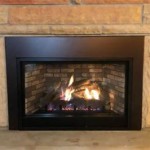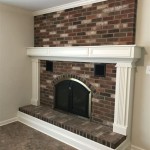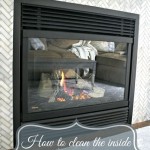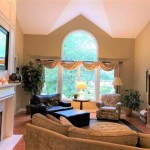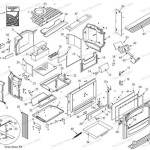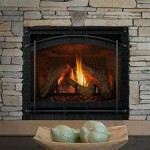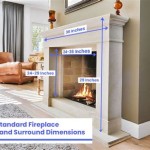Installing a Gas Fireplace: A Comprehensive Guide
Installing a gas fireplace is a significant home improvement project that can add warmth, ambiance, and value to a property. It involves complexities related to gas lines, venting, and electrical connections, requiring careful planning and adherence to local building codes. This article provides a comprehensive overview of the process, covering essential considerations and steps for a successful installation.
Prior to commencing any work, it is imperative to consult local building codes and regulations. These codes vary by region and municipality, dictating specific requirements for gas appliance installations, including venting specifications, gas line sizing, and permit acquisition. Neglecting to comply with these regulations can result in fines, delays, and potential safety hazards. A local building inspector can provide detailed information regarding applicable codes and permit requirements.
Furthermore, it is strongly recommended to engage a qualified, licensed gas fitter or HVAC technician for this project. These professionals possess the necessary expertise and experience to ensure the installation is performed safely and correctly. Improper installation can lead to gas leaks, carbon monoxide poisoning, or fire hazards, making it a serious risk to both occupants and the property. A professional installer will also be familiar with local codes and can handle the permit process.
Choosing the right gas fireplace for the space is crucial. Different models offer varying heat outputs, venting options, and aesthetic designs. The size of the room to be heated, the desired style, and the existing structure of the home will all influence the selection process. Consider factors such as BTU rating (British Thermal Units), venting type (direct vent, B-vent, vent-free), and fuel type (natural gas or propane). Direct vent fireplaces are generally considered the safest and most efficient option, as they draw combustion air from outside and vent exhaust gases directly outside as well, preventing indoor air pollution.
Key Point 1: Planning and Preparation
Thorough planning is the foundation of a successful gas fireplace installation. This phase involves several critical steps:
1. Site Assessment: Begin by assessing the intended installation location. Evaluate the existing structure, including wall framing, floor joists, and ceiling height. Identify any potential obstructions, such as pipes, wiring, or ductwork, that may need to be relocated. Determine the proximity to existing gas lines and electrical outlets. A detailed assessment will help determine the feasibility of the installation and identify any potential challenges.
2. Venting Considerations: Determine the appropriate venting method based on the chosen fireplace model and the structure of the home. Direct vent fireplaces typically require an outside wall for direct venting, while B-vent fireplaces require a chimney or vertical vent. Vent-free fireplaces, while offering more flexibility in placement, are subject to stricter regulations and may not be permitted in all jurisdictions. Ensure that the venting system complies with manufacturer specifications and local building codes.
3. Gas Line Assessment: Evaluate the existing gas line capacity and pressure to ensure it can adequately supply the new fireplace. A licensed gas fitter can perform a gas pressure test and calculate the gas line capacity needed for the fireplace. If the existing gas line is undersized, it may need to be upgraded or a new line installed from the gas meter to the fireplace location. This is a critical step to avoid gas starvation and ensure proper fireplace operation.
4. Electrical Requirements: Most gas fireplaces require an electrical connection for the ignition system, blower fan (if equipped), and any optional features such as remote controls or thermostats. A dedicated electrical circuit may be necessary, depending on the fireplace's power requirements and the existing electrical load in the area. Consult an electrician to determine the appropriate wiring and circuit breaker size.
5. Permit Acquisition: Obtain the necessary building permits from the local municipality before commencing any installation work. The permit application typically requires submitting detailed plans of the installation, including venting schematics, gas line diagrams, and electrical wiring layouts. The permitting process ensures that the installation complies with local building codes and safety regulations.
6. Material Procurement: Gather all the necessary materials and tools for the installation, including the fireplace unit, venting components, gas piping, electrical wiring, insulation, and any finishing materials. Ensure that all materials are approved for use with gas appliances and comply with applicable safety standards. Having all the materials on hand before starting the installation will minimize delays and ensure a smooth workflow.
Key Point 2: Gas Fireplace Installation Procedures
The installation process involves several distinct steps, each requiring precision and attention to detail.
1. Gas Line Connection: A licensed gas fitter should perform the gas line connection. This involves tapping into the existing gas line, installing a shut-off valve, and running a gas line to the fireplace location. The gas line must be properly sized to provide adequate gas pressure and flow to the fireplace. All gas line connections must be leak-tested using a non-corrosive leak detection solution to ensure there are no gas leaks. This step is crucial for safety and should never be attempted by anyone without proper training and certification.
2. Venting Installation: Install the venting system according to the manufacturer's instructions and local building codes. Ensure that all venting connections are properly sealed and secured to prevent exhaust gas leaks. The venting system should be installed with the correct slope and clearances to prevent condensation buildup and ensure proper draft. Pay close attention to the type of venting system and the required clearances to combustible materials.
3. Fireplace Placement and Securing: Position the fireplace in the designated location and secure it to the wall or floor according to the manufacturer's instructions. Ensure that the fireplace is level and plumb. Provide adequate clearance around the fireplace for ventilation and access for maintenance. The fireplace should be properly anchored to prevent it from tipping over or shifting during operation.
4. Electrical Connection: Connect the electrical wiring to the fireplace according to the manufacturer's instructions and local electrical codes. Ensure that the wiring is properly grounded and protected from damage. Use the correct wire gauge and connectors for the electrical connection. If necessary, install a dedicated circuit breaker for the fireplace. This step requires knowledge of electrical safety and should be performed or supervised by a qualified electrician.
5. Testing and Commissioning: After completing the installation, thoroughly test the fireplace to ensure it is operating correctly. Turn on the gas supply and ignite the pilot light (if applicable). Check the flame pattern and adjust the gas pressure if necessary. Verify that the blower fan (if equipped) is functioning properly. Inspect the venting system for any signs of leaks or obstructions. This step is crucial to ensure the fireplace is safe and operating efficiently.
6. Finishing and Aesthetics: Once the fireplace is functioning correctly, complete the finishing touches, such as installing decorative surrounds, mantels, or trim. Ensure that all finishing materials are non-combustible and comply with local building codes. The finishing touches should enhance the aesthetic appeal of the fireplace and integrate it seamlessly into the surrounding decor.
Key Point 3: Safety Considerations and Maintenance
Safety is paramount when dealing with gas appliances. Regular maintenance is also essential to ensure the safe and efficient operation of the gas fireplace.
1. Carbon Monoxide Detectors: Install carbon monoxide (CO) detectors in the vicinity of the gas fireplace. CO is a colorless, odorless gas that can be produced by incomplete combustion. CO detectors provide an early warning of CO buildup and can save lives. Test the CO detectors regularly to ensure they are functioning properly.
2. Gas Leak Detection: Regularly inspect the gas connections for any signs of gas leaks. Use a non-corrosive leak detection solution to check for leaks around the gas line connections and the fireplace. If a gas leak is suspected, immediately shut off the gas supply at the shut-off valve and contact a qualified gas fitter or the gas company. Never use an open flame to check for gas leaks.
3. Venting System Inspection: Inspect the venting system regularly for any signs of obstructions, damage, or corrosion. Ensure that the vent cap is clear of debris and that the vent is properly secured. A blocked or damaged vent can lead to carbon monoxide buildup and pose a serious safety hazard. Have the venting system professionally inspected and cleaned at least once a year.
4. Fireplace Cleaning: Clean the fireplace regularly to remove dust, soot, and debris. Use a soft brush or vacuum cleaner to clean the interior of the fireplace and the venting system. Avoid using abrasive cleaners or solvents, as they can damage the fireplace components. Regular cleaning will help maintain the fireplace's efficiency and prevent potential fire hazards.
5. Professional Maintenance: Schedule regular maintenance and inspections by a qualified gas fitter or HVAC technician. A professional inspection can identify potential problems before they become serious and ensure that the fireplace is operating safely and efficiently. The technician can also clean and adjust the fireplace components, such as the burner and pilot light, to optimize performance.
6. Manual and Warranty Review: Thoroughly read and understand the manufacturer's instructions and warranty information. Adhere to the recommended maintenance schedule and operating procedures. Keep the manual in a safe place for future reference. The manufacturer's manual provides valuable information about the fireplace's operation, maintenance, and troubleshooting. Following the manufacturer's recommendations will help ensure the fireplace's longevity and safety.
Installing a gas fireplace is a complex endeavor that demands meticulous planning, precise execution, and unwavering adherence to safety protocols. While this guide offers a comprehensive overview, engaging qualified professionals is highly recommended to mitigate risks and ensure a successful and safe installation that provides years of warmth and enjoyment.
How To Install Gas Fireplace Insert Heat Glo

How To Install A Fireplace Insert Diy Save Money

Convert To Gas Installing Fireplace Inserts Doctor Flue

7 Benefits Of Installing A Gas Fireplace Low Maintenance Much More

How To Select And Install A Gas Fireplace Log Set Fireplaces Direct Learning Center

Cozy Up Your Home With A Gas Fireplace

Installing A Gas Fireplace

Fireplace Installations Near Dc Chimney Experts

If You Have A Gas Fireplace It May Or Not Chimney Flue

Efficient Prefab Gas Fireplaces Fireplace Showroom In Tilton Nh
Related Posts

